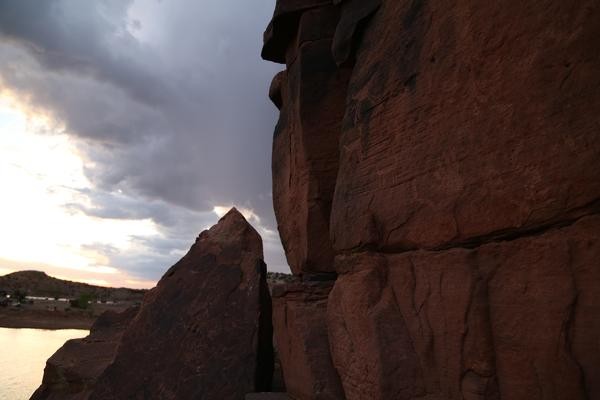There is currently no drinking water at the park. Restrooms and showers are fully functional.
Science
Ecology Overview
 Lyman Lake Petroglyphs
Lyman Lake PetroglyphsLyman Lake State Park is located in eastern Arizona near St. Johns at an elevation of 6,000 feet. The park offers cabins, camping, fishing, boating, wildlife watching and hiking trails featuring petrogylphs. The lake is human created and harnesses snowmelt from nearby Mount Baldy and Escudilla Mountain. It is one of the few lakes in northeastern Arizona without any restriction on boat size.
The park has vegetation dominated by pinyon (Pinus spp.) and juniper (Juniperus spp.) and is characterized as Great Basin Conifer Woodland (Brown 52). Other common vegetation in this area include oaks (Quercus spp.), shrubs like threadleaf groundsel (Senecio longilobus) and snakeweed (Gutierrezia sarothrae), and many native bunch grasses such as galleta grass (Hilaria jamesii), ricegrass (used to be Oryzopsis hymenoides has been reclassified as Achnatherum hymenoides), and western wheatgrass (Pascopyrum smithii). Wildflowers include numerous penstemon species, sego lily (Calochortus nuttalli), a number of globemallows (Sphaeralcea spp.), and several lupines (Lupinus spp.)
Many small mammals are associated with this vegetative classification and make their home in Lyman Lake State Park. This type of habitat also provides critical winter homes for Rocky Mountain elk (Cervus canadensis), bald and golden eagles (Haliaeeatus leucocephalus and Aquila chrysaetos), and mule deer (Odocoileus hemionus). Other birds in the park include osprey (Pandion haliaeatus), egret (Egretta sp.), sandhill crane (Grus canadensis), and mountain bluebird (Sialia currucoides). Reptiles found in the park include the plateau striped whiptail (Cnemidophorus velox) and sagebrush lizard (Sceloporus graciosus).
Like many areas of Arizona, Lyman Lake State Park is also home to non-native plants and animals. These non-native species arrive in a variety of ways; some species have been accidentally introduced and humans introduced some purposefully. Tamarisk (Tamarix sp.) and Russian olive (Eleagnus angustifolia) are two non-native trees found in the park.
Cultural History
The Lyman Lake State Park area appears to have been continuously occupied by Ancestral Puebloans sometime after 6000 BC. Based on current understanding of the Ancestral Puebloan culture, they were originally hunters and gatherers, living in small, temporary campsites, depending on seasonal grasses, nuts, berries, and game for food. By the first century AD, they began cultivating corn, beans, cotton, squash, and other domesticated plants introduced from Mexico. Crops may have originally be raised in plots where moisture was dependent on rainfall. Later, particularly after about 1300 AD, floodplain irrigation may have been practiced.
By 500 AD, as the Ancestral Puebloans became more sedentary, they began developing more permanent, semi-underground dwellings. Totally above surface structures begin appearing between 900 and 1100 AD. These structures gradually become large masonry pueblos that were concentrated along the Little Colorado River near major confluences with other streams. Several large pueblos dating from 1300-1400 AD are located in the Lyman Lake State Park area.
Petroglyphs are very common to the area and can be viewed along the Peninsula Petroglyph Trail and the Ultimate Petroglyph Trail. The petroglyph hike is very popular and occurs several times throughout the year. Park rangers will discuss Ancestral Pueblo culture and other interesting information about the people who spanned this area.



